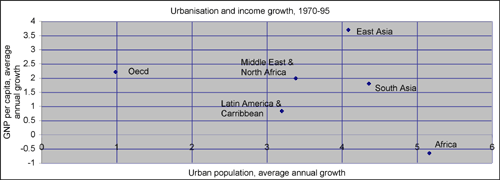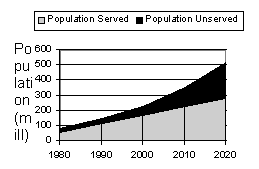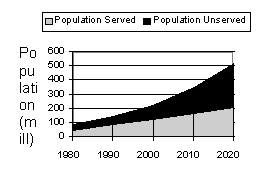|
Many unique factors have contributed to this phenomenon in urban Africa, including inmigration of destitute citizens due to wars, drought and famine, difficult transitions from neo-apartheid colonial regimes to fragile self-governance, and crushing external debt (81% of GDP in Africa compared to 33% in East Asia). As regional conflicts are resolved and structural adjustments bear fruit, the need to build the capacity for African cities to become equitable generators of wealth is becoming paramount.
• Poverty in Africa is becoming a predominantly Urban Issue
By the year 2025, the majority of the poor in Africa will be living in urban as opposed to rural areas. Moreover, the political and socio-economic externalities of urban poverty are likely to be much more costly than rural poverty (e.g. crime, instability, and spread of disease)
• Quantifying the Need: 300 Million Urban Africans without Water and Sanitation by 2020
As shown in Figure 1, assuming that current levels of investment in urban water supply and sanitation continue in sub-Saharan Africa over the next 20 years, as many as 300 million people will be without sanitation and 225 million without potable supplies of water in African cities by 2020 (African Water Resources, World Bank Technical Paper no. 331, 1996).
|
|
• African urban programs should focus on sustainability
Some of the earliest examples of Bank-assisted upgrading projects took place in Africa, starting in Lusaka in the mid-‘70s. As in the rest of the Bank’s global upgrading portfolio, there were successes and failures in Africa. In the ‘80s, however, debt, war and drought caused severe structural constraints on many of the region’s economies and dwindling central government resources were inadequate to maintain investments in upgrading and other types of infrastructure for which direct cost recovery could not achieved.
Bank-assisted urban projects in the region adapted accordingly, focussing more on reform, capacity building and preservation of existing infrastructure, although particularly in West Africa more modest upgrading projects continued to be implemented. In the ‘90s this focus on building capacity to manage and sustain cities has continued. As structural reforms take hold, central governments are increasingly willing to allow, even push, local governments to become more autonomous and less dependent upon central resources. As the decade ends, a number of key opportunities appear to be emerging across the region.
- Decentralization of responsibility and authority for financing and sustaining urban infrastructure investments. To become net producers of national wealth, urban economies must generate revenue streams adequate to finance and maintain the core public infrastructure upon which private investment can flourish. Most African (and other developing) cities have never achieved sustainable operations due largely to a) capacity constraints, b) central/political interference and control, particularly with regard to tariffs, and c) inappropriate intergovernmental fiscal relations. A key opportunity now presents itself as more countries throughout the region realize that central control over and financing of local infrastructure is structurally insupportable. Thus, many countries are now moving to decentralization of responsibility for local infrastructure and services. While most local authorities still face capacity constraints, the potential for sustainable local operations—in tandem with new accountability brought about by democratization and the emergence of civil society—is significant and has become the focus of Bank support to the sector in Africa.
- Reductions in central control over local resources. In addition to politically popular but unsustainable central oversight in setting of local tariffs and rates, in most African countries the center controls access to land. While wealthy citizens and investors have been able to secure urban land for investment, in most African countries the poor majority populations have been unable to secure clear, marketable tenure over land. Lack of secure tenure constrains private investment and prevents local governments from establishing value driven rating bases to sustain investments and services. Occupancy permits and similar tenure devices controlled by government officials are impermanent, promote rent seeking, and prevent development of transparent land markets that create wealth and encourage efficient land utilization. A key opportunity now presents itself in the new willingness of governments from Benin to Swaziland to make urban land tenure truly secure through issuance of bankable titles, deeds and long term leases. While access to secure urban land tenure alone will not drive productivity gains, it is a critical ingredient to those gains and requires heightened emphasis throughout the region.
- Biases against the urban poor are diminishing. Many African cities have remained wedded to out-dated land use plans and planning controls that, explicitly or implicitly, seek to exclude the poor. While many countries, particularly in West Africa, have continued to implement slum upgrading projects, no country in the region—excepting possibly South Africa—has comprehensively reformed urban development strategies to build upon, rather than attempt to exclude, the potential that exists in urban poor populations. An important opportunity now presents itself as more countries, through the process of democratization and in light of the inevitable tide of migration to cities, evidence new willingness to discard centralized development controls and allow the emergency of urban land markets. Support should be provided to governments willing to pursue incremental, community based solutions to productivity constraints faced by the urban poor.
- The inevitability of African urbanization is readily apparent. Debate over the demographic evidence for regional urbanization is now moot. The reality of Africans flocking to cities in rapidly growing numbers renders arguments over “push” versus “pull” truly academic. The fact is that Africa’s urban populations are exploding and will continue to do so for the foreseeable future. Thus, a final key opportunity presents itself in the growing realization by governments in the region that rapid urbanization is here to stay. Responsive leaders realize that the demands of growing urban populations must be met and new approaches to development, including expansion of public-private partnerships, are both inevitable and desirable. Among many of the region’s new leaders there is a fresh willingness to learn about new approaches to urban poverty alleviation that have succeeded within Africa and in other regions.
The Bank is uniquely positioned to facilitate this willingness to learn and adapt. A renewed emphasis on slum upgrading could meet with new acceptance and success in many countries in the region. But slum upgrading in Africa, or any other region, will be sustainable at scale only if it is firmly ensconced within a framework of sound urban management based on local accountability, autonomy and equitable distribution of wealth. It is on this pragmatic principle that the Africa region’s action plan for slum upgrading is based.
• Sustainable Upgrading: Key Indicators for Success from Lessons Learned
The prospect of 300 million new slum dwellers in African cities by 2020 is daunting. Provision of basic services to this population is obviously necessary, but hardly sufficient. For African economies to grow in the 21st century, the region’s cities must become net providers of national wealth. With 700 million people residing in almost 3000 cities by 2025 (tables 1 and 2), the majority of the region’s economic production should be generated in urban places (in South Africa, for example, about 85% of GDP is already produced in cities). Achievement of this goal will obviously require enormous human and financial resources. Lessons learned from past experience with upgrading and urban infrastructure investments should guide efficient deployment of resources to meet Africa’s urban challenge over the next 25 years. Key lessons learned in the ‘70s and ‘80s generation of Bank-assisted upgrading projects include:
- Upgrading must meet real demand through sustainable means. Many of the early upgrading projects were driven from the top down and, as a result, community and local authority “ownership” of projects did not develop. Hence, a new emphasis on upgrading in Africa must be founded upon local partnerships that deliver priority investments through incremental means affordable to communities and sustainable at the local level. A key indicator for countries in which this approach may be successful will be central government willingness to support decentralized decision making by local authorities and communities.
- Local sustainability depends both on good city management and appropriate intergovernmental fiscal arrangements. Table 2 shows that the number of cities with populations in excess of 20,000 will nearly triple in the next 20 years. The demand for good city managers, already in short supply throughout the region, will increase drastically. At the same time, central governments must come fully to grips with their responsibilities to promote local autonomy and capacity on a firm intergovernmental fiscal base. Cities become economically productive only when their expenditure assignments and revenue bases are in balance. One of the key problems that faced earlier Bank-assisted upgrading projects was central government reluctance to provide local authorities with clear expenditure responsibilities, predictable fiscal bases, and autonomy to manage effectively. Thus, a second key indicator for the potential success of urban upgrading will be central government willingness to undertake necessary fiscal reforms and allow local authorities to provide conditions of service necessary to attract and retain competent managers.
- Slum upgrading contributes most effectively to urban productivity when real, marketable wealth is created. Another key lesson learned in the upgrading projects of 20 years ago was that poverty alleviation was most effective in projects that delivered secure, marketable instruments of tenure to slum residents. In the Philippines and Indonesia, for instance, many 20 year old upgrading projects are now thriving working class neighborhoods in which residents have used their real property assets to leverage investment capital. In many African countries, the urban poor are still granted only temporary tenure, like occupancy permits, that are not fully bankable and do not promote the emergence of real property markets and corresponding property tax systems that can sustain local government operations. Thus, an additional indicator of potential for upgrading success will be central government willingness to grant clear titles or other durable tenure instruments and local government capacity to capture and responsibly invest real property taxes.
- Insistence on full recovery of upgrading costs directly from the urban poor beneficiaries may detract from sustainability and productivity goals. The value of upgraded land to local and national economies can be enormous, with values increasing ten-fold over comparable unserviced land. Slums on land owned by government are by definition unproductive in other than gray market terms. Upgrading programs of 20 years ago sometimes foundered on insistence that beneficiaries directly repay all costs, and failure to do so caused programs to be abandoned. In the ensuing decades, a number of countries in LAC and South Africa have experimented with subsidies that expedite ownership of land by the poor and create national wealth by mobilizing formally unproductive land. While most African governments probably cannot sustain upgrading subsidies from own fiscal resources, donors may find such an opportunity attractive. Therefore, a final key indicator for potential upgrading success in Africa will be willingness by both governments and donors to examine the potential for national wealth creation through targeted subsidies that bring slums into the formal economy.
|




